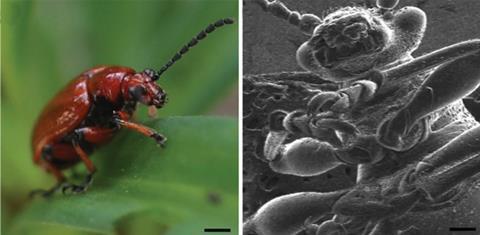A protective ‘nano-suit’ made from a common detergent protects specimens in a vacuum

Two years ago we reported that Takahiko Hariyama’s group at Hamamatsu University in Japan had developed a coating that allowed insect larvae to survive in the vacuum chamber of a scanning electron microscope, enabling whole living creatures to be imaged at very high resolution.
Now, Hariyama and colleagues have applied the nano-suit treatment to other organisms, which has allowed them to take more stunningly detailed close-up images – zooming in on the hairy legs of a live leaf beetle, for example. They also showed the protective coating could prevent some of the damage and distortion that occurred when specimens were prepared in the normal way, and say the technique could pave the way for better imaging protocols that produce more accurate pictures.
The protective coating is made of a common lab detergent, Tween 20, into which specimens are simply dipped before putting them in the vacuum chamber. When exposed to the microscope’s electron beam, it is thought the amphiphilic molecules in Tween 20 polymerise and form a protective coating or ‘nano-suit’, preventing the rapid moisture loss and fatal shrivelling that would otherwise kill the insects.













No comments yet